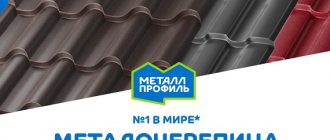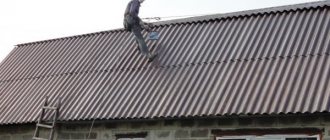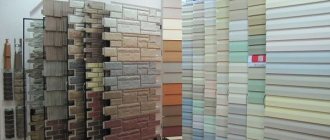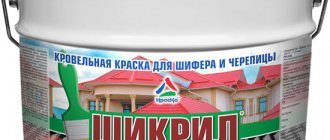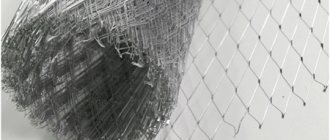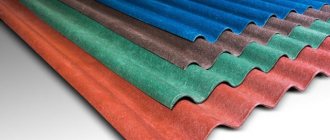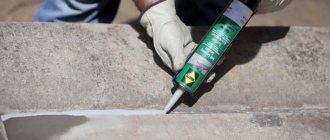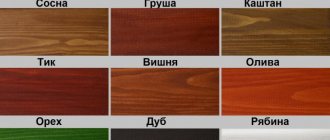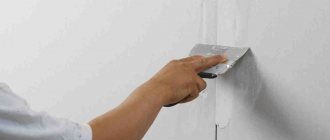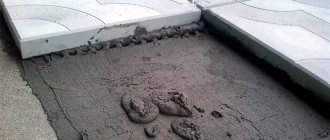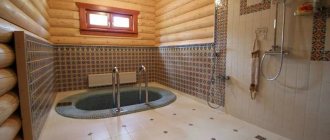The façade finishing market is represented by a wide variety of specialized varieties. But owners of private houses are trying to adapt for these purposes other, universal materials with properties corresponding to the intended scope of application. Such an experience is not always successful, but the owners of houses lined with flat slate, among whom there are FORUMHOUSE craftsmen, are quite satisfied. Before repeating their method or unconditionally rejecting it, let’s understand all the subtleties.
Description of material
Slate is made from asbestos and Portland cement, therefore it has high strength, durability, and relatively low weight. It is perfect for arranging roofs, fences, interior decoration of balconies and non-residential premises.
It is quite convenient to work with such building materials. It is easy to cut with a saw and does not break during sawing. But in the process of interacting with asbestos-cement material, it is extremely important to comply with safety requirements: asbestos dust should not penetrate the respiratory system.
Flat slate comes in a huge variety of sizes. A wide range of such products in stores makes it easy to select the required size of sheets. When installing them, there is practically no waste left, so the material is used very economically.
Flat slate is quite fragile, but at the same time it is not afraid of acids, alkalis, low or high temperatures, does not absorb moisture, does not burn, does not fade under UV rays Source stroy-podskazka.ru
Product Specifications
All flat slate on the market is divided into two options - pressed and unpressed. Their technical characteristics are very diverse and now we will show you this:
- Density - 1.6 g/cm3 for the unpressed version and 1.8 g/cm3 for the pressed version;
- Strength – 18 MPa for the unpressed version, and 23 MPa for the pressed version;
- Frost resistance - 25 cycles of freezing and thawing for unpressed, and 50 cycles for pressed. Moreover, the residual strength after passing through these cycles is 90 percent for unpressed slate, and 40 percent for pressed flat slate;
- Impact strength is 2 kJ/m2 for the unpressed version and 2.5 kJ/m2 for the pressed version.
Slate sheets reach 2.5 meters in length, 1.2 meters in width, and their thickness is 6.8 millimeters. In this case, the pressed version usually has a smaller percentage of deviations from linear dimensions.
Advantages and disadvantages
Before covering a house with flat slate, it is advisable to familiarize yourself with the main advantages of such building materials:
- long service life (up to 30 years);
- affordable price;
- resistance to corrosion processes and biological influences;
- significant bending strength;
- inertness to temperature fluctuations;
- fire safety;
- good frost resistance;
- good soundproofing qualities;
- reflects ultraviolet light;
- does not allow electric current to pass through;
- easy to install.
Flat slate reliably protects surfaces from destructive external influences for many years Source stroy-podskazka.ru
- difficulty of transportation (due to significant weight and fragility of products);
- the need to treat the material with antiseptic agents to prevent the spread of moss;
- installation of such building materials is difficult to carry out alone;
- sawing sheets leads to the formation of asbestos dust, which is extremely dangerous for the human body;
- susceptibility to point loads.
Despite the above disadvantages, finishing the base with flat slate is used quite often today. This is due to the ability to perform installation work yourself and save money.
Helpful information! Asbestos cement sheets do not belong to the group of flammable building materials, but under the influence of open fire they are capable of “shooting”.
During the cutting process of slate, asbestos dust harmful to the human body is formed, therefore it is important to carry out all work using protective equipment Source i.ytimg.com
Construction of houses
0 votes
+
Vote for!
—
Vote against!
There are two slate options - flat and wave. The first option has a wider application, in addition to covering the roof. It is also used to construct outbuildings and finish the façade of a house. We’ll talk further about how to build a slate house yourself and cover a house with slate.
Table of contents:
- Cladding a house with slate: features of the material
- How to sheathe a house with flat slate - recommendations
- How to cover a house with slate with your own hands - technology
- Features of finishing a house with slate: ventilation façade structures
- How to paint flat slate on a house
Cladding a house with slate: features of the material
Slate is a fairly popular and inexpensive finishing material. It is most often used to finish roofing. Slate contains asbestos, cement and additional fillers.
It should also be said about the high practicality of slate, which, after dismantling from the roof, is also used for other purposes, for example, to build a fence. In the process of making slate, all the ingredients are combined in a certain proportion. In this case, a substance in the form of asbestos is used as a reinforcing base. It strengthens the slate and increases its resistance to mechanical stress. To harden the composition, special molds are used that allow you to obtain a certain texture.
There are two options for making slate sheets:
- Pressed slate is characterized by resistance to low temperatures, high impact strength, bending strength and good performance characteristics.
- Unpressed slate does not have such high strength indicators, but is used for interior decoration.
The manufacturer indicates all the performance properties of slate on its label. Therefore, when choosing slate, be sure to familiarize yourself with them.
The service life of slate on the roof of a house also determines the amount of asbestos in its composition, the characteristics of the substance itself, the length of the fibers, their mechanical strength, grinding quality, equipment for making slate.
Most often, the shape of slate is rectangular, although some manufacturers make it in different variations. Among the main advantages of slate we note:
- affordable cost of the material in relation to its high performance properties;
- duration of operation, which is explained by the breadth of its application;
- resistance to ultraviolet radiation and heat from the sun;
- high mechanical strength, allowing it to withstand the weight of an average person;
- processing using mechanical tools;
- no sounds during rain, good soundproofing characteristics;
- lack of conductivity of electricity;
- resistance to corrosion and high humidity;
- maintainability, possibility of partial replacement if damaged.
How to sheathe a house with flat slate - recommendations
Flat slate is quite often used in the process of finishing facades. In addition, this material is popular in the industrial construction industry, even in the manufacture of certain types of formwork, fences and agricultural buildings.
Sheets of flat slate are widely used in summer cottages; they are used to construct outbuildings, shower cabins and roofs. Using flat sheets of slate, the facade is covered, a dry screed is installed and walls are erected. In addition, the use of the material when finishing balconies is widespread.
The widespread use of flat slate is due to its following characteristics:
- availability of material and low price;
- The service life of slate is more than 12 years;
- high level of impact resistance;
- high level of sound insulation;
- Fire safety;
- resistance to the development of mold and various types of fungi;
- resistance to moisture.
Despite this, when cladding a house using flat slate, it is necessary to take into account the following disadvantages:
- installation of slate must be carried out by at least two people;
- when working with sheets, special care should be taken, since this material, although capable of supporting the weight of an adult, is particularly fragile;
- in order to prevent the development of fungus, mold and moss on the surface of the slate, it must be coated with special compounds.
In principle, having studied all the disadvantages and advantages of this material, we can draw conclusions that it is ideal for finishing the facade. However, in this case, a minimum of two people will be required for the work.
How to cover a house with slate with your own hands - technology
Since slate is a fairly fragile material, special care and skill should be exercised when working with it. Before starting work, familiarize yourself with the features of working with slate:
- since slate contains asbestos, it is recommended to wear a respirator when working with it, which will protect the person cutting the slate from dust;
- the minimum cutting thickness of the slate strip is 0.6 cm, otherwise deformation and destruction of its edges will occur;
- to treat freshly cut sections of slate, use acrylic paint;
- before installing the nail in the slate, first make a hole for it using a drill;
- Before installing each sheet, inspect it for damage or deformation.
The slate is installed on a previously prepared frame. Most often, wooden boards or timber are used to make it. The interval for laying wood for sheathing depends on the size of the sheet and is most often 60 cm. If necessary, waterproofing and thermal insulation materials are installed before laying the sheets.
Before starting work, inspect the slate for damage and set aside damaged sheets. Next, it is recommended to pre-cut the sheets according to the dimensions of the wall and begin their installation.
Cover the house with flat slate photo:
The process of cutting slate is quite complex and requires special skills in working with this material. To carry it out correctly, follow these steps:
- if the sheet thickness is more than 0.6 cm, initially you need to mark the place of the cut with a ruler and pencil, then make a notch on each side and place the sheet on the table in such a way that it is convenient for you to break it;
- with a larger sheet thickness, a special saw is used to cut the slate; while cutting, cool the slate with cold water.
Self-tapping screws are used to secure the slate to the surface of the sheathing. Before installing them, it is necessary to pre-drill a hole, otherwise the slate may burst. To cover the screw heads, special covers are used. After installing the slate, it is treated with special protective compounds that prevent the development of moss on its surface. If necessary, the slate is painted in a color suitable for the exterior.
Features of finishing a house with slate: ventilation façade structures
A ventilated façade is a building finishing technology that leaves space between its main wall and the finishing material for the façade for normal air circulation. At the same time, with the help of an air gap it is possible to get rid of condensation and steam coming out of the walls. The optimal air gap value is selected individually for each building and ranges from twenty to fifty centimeters.
Sheathing a house with slate photo:
When installing a ventilated façade, you must perform the following steps:
- Install a frame made of wooden beams or boards on the wall. It is possible to use a metal frame to make the sheathing. Before installing wooden structures, they must be treated with special compounds.
- If necessary, insulation is placed between the frame. If mineral wool was used as a thermal insulation material, then the installation of a waterproofing material in the form of a moisture-proof membrane will be required.
- Next, the counter batten is installed, which provides the necessary ventilation space. Next, slate is already fixed on it, performing the function of the external finishing material of the ventilated facade.
If there is no need to insulate the walls, then the insulation is not installed, and the interval between the frames is about 5 cm. It is possible to purchase a ready-made kit for a ventilated facade. In this case, its installation and construction will be faster.
At the initial stage of designing a ventilated facade, the type of material from which the sheathing will be constructed is determined. Next, you should determine the need to install insulation, its thickness and type. If the thickness of the insulation is more than 10 cm, then it will also serve as an excellent sound insulator. The thickness of the boards used during the installation of the sheathing is determined by the presence or absence of insulation.
Next, decide on the amount of material needed to install a ventilated façade. When insulating a facade, we recommend choosing a mineral wool type of insulation; it has higher performance properties than foam plastic. The base must be insulated with extruded polystyrene foam.
Using slate in arranging a ventilated facade has the following advantages:
- installed both in winter and summer, regardless of temperature;
- duration of operation;
- high level of thermal insulation and protection of the house from extraneous sounds;
- variety of materials for making facades;
- resistance to atmospheric influences.
In addition, after installing the slate, it is painted in any desired shade and acquires additional aesthetic appeal. A slate house is, on the one hand, a cheap but at the same time practical option. The service life of a ventilated facade is more than 16 years, with proper care of the slate. If necessary, damaged slate can be easily dismantled and replaced with a new one.
How to paint flat slate on a house
Choosing the right paint for flat slate will not only provide an attractive surface to the walls of your home, but also improve the performance characteristics of the material. Incorrectly selected paint for slate will peel off its surface within six months.
Since slate is outdoors and is exposed to ultraviolet radiation, moisture and temperature changes, the paint must be resistant to all these factors.
The use of simple enamel is strongly recommended for covering slate. Because after a certain time has passed since the paint was applied, it begins to slide off the surface, forming rags on the slate.
In order to protect slate from moisture, it is recommended to use acrylic-based paint. In addition, this paint option is distinguished by a wide color palette, bright and saturated colors that are not prone to fading.
If slate is constantly exposed to wind, then painting it with silicone paint is not recommended, as it will eventually lose color and turn gray.
An excellent option is a combination of silicate and acrylic paint. In this case, the paint protects the slate surface from dirt and dust and has high moisture-repellent properties.
Another option for covering and protecting slate from external factors is liquid rubber. After application to the surface, it forms a dense film characterized by elasticity and durability. And the presence of special pigments in the paint prevents it from fading.
However, rubber paints are highly toxic, so they are used exclusively outdoors. At the same time, wear a protective mask and goggles when working with paint.
In any case, before applying paint, the slate is coated with a primer. It protects the coating from fungus and mold. It is recommended to apply the primer in two layers. At the same time, wait until each layer has completely dried. Next, paint is applied to the slate; initially, it is recommended to apply one coat of paint, wait until it dries, paint the walls several more times. This way you can achieve a rich color. Paint the slate before installing it on the walls; in this case, it is recommended to install the material in a strictly horizontal position.
There is slate that is factory painted, in which case you can save time and physical resources for painting. Although the cost of such material is somewhat more expensive than buying ordinary slate and painting it.
Facade finishing with flat slate
High-quality cladding of a house with asbestos-cement panels has many advantages. This material is highly fire resistant, durable, and does not absorb moisture. All this is extremely important for external walls that are constantly exposed to weather conditions.
The main disadvantage of flat slate is its insufficiently attractive appearance. It is not at all suitable for creating architectural delights. If the surface of such a building material is not treated with a special compound, it will soon become covered with moss. Therefore, before covering any house with flat slate, you need to apply a final protective layer. It will also help improve the waterproofing of the base. In addition, it is worth noting: the structure of the material does not change over time.
It is advisable to cut elements onto the façade using a diamond circular saw or a stone-cutting machine. It is important to take into account: a lot of dust is generated. To eliminate it, it is better to immediately use a vacuum cleaner.
To add attractiveness to gray walls, various coloring agents are used. All painted flat slate surfaces require periodic refinishing. This does not depend on the quality of the paint used.
The use of polyurethane and acrylic compounds for painting flat slate eliminates further external influence on the material Source stolica-s.su
Disadvantages of asbestos cement sheet
Actually, the main drawback is indicated in the name itself - the material contains asbestos, which belongs to the category of carcinogens (substances that can cause cancer). However, the main danger of asbestos particles is during inhalation during cutting and installation. Contact with the material itself, as previously proven, does not have any harmful consequences. However, the bad reputation of asbestos is still strong, and therefore not many people decide to use the material for finishing residential premises and even residential buildings.
The second important disadvantage is the lack of bright colors and a wide variety of appearance. These are mostly gray colors, which are not suitable everywhere. For example, if a barn or a fence can be upholstered with it, then the gray concrete surface of a house can be confusing. Although, at the moment you can try to look for color variations on the market.
The disadvantages include the large mass, which makes the work of installing sheets alone almost impossible. Enlist support also because the sheets are very fragile and can be easily broken.
The nuances of finishing the base with flat slate
It is possible to finish the foundation of a building with high-quality asbestos-cement panels yourself. This does not require special knowledge or skills. The process itself involves the preliminary installation of sheathing intended for further fastening of sheets. If necessary, a layer of heat insulation is placed inside the frame, which will further insulate the house.
If it is necessary to additionally insulate the house, it is recommended to install flat slate simultaneously with insulation material Source par-torg.com
The panels are connected to the sheathing using self-tapping screws. It is undesirable to use nails: a point load on the material can provoke a violation of its integrity. To prevent the panels from cracking during installation, you should make mounting holes in advance, then apply fixing elements.
When finishing the base with flat slate, you need to calculate the amount of building materials and fasteners in advance. To do this, you need to measure the dimensions of the foundation. Purchased sheets should be checked for solidity: they are often damaged during transportation.
You need to cut the panels like this:
- Place the sheet on a flat surface.
- Make several notches in the required place.
- Using a cutter, cut the product slightly.
- Carefully break the element.
Advice! If the thickness of the asbestos cement panel exceeds 10 mm, it is advisable to use an electric saw.
A wooden or metal frame for installing flat slate is constructed by analogy with plasterboard structures Source xvrn.ru
Dimensions and weight
Sheets of flat slate, in contrast to asbestos-cement tiles such as eternit, are quite large. This explains some narrowing of their scope of use (especially as a finishing roofing covering).
Sheet sizes are regulated by GOST 18124-2012 or enterprise specifications. According to GOST, the length of products is several specific values in the range of 1200-3600 mm, width - in the range of 1120-1570 mm, thickness - 6-8, 10 mm.
The weight of flat sheets, due to their dimensions, is also quite large. A square meter of unpressed sheet, 10 mm thick, weighs about 19 kg, and a pressed sheet weighs about 21 kg. That is, the weight of a standard pressed sheet with a thickness of 10 mm, a length of 3 m, and a width of 1.5 m will be equal to 96 kg, and an unpressed sheet will be about 87 kg. The indicated figures may have slight errors, depending on the additives used and the humidity of the product.
Finishing the base with flat slate: sequence of work
The basement base should be finished with asbestos cement sheets in the following sequence:
- Prepare the surface for installation: level, treat with an antiseptic, lay waterproofing.
- Install the sheathing. It is important to install frame racks at a distance that corresponds to the size of the panel.
- If it is necessary to strengthen the thermal insulation, lay a layer of insulation inside the sheathing.
- Starting from the corner, attach the prepared elements to the frame using self-tapping screws. They must be inserted into pre-drilled holes.
- Carefully treat the corners with galvanized metal parts.
- Secure the corners with screws.
- Apply coloring agent to the surface. To do this, it is advisable to use acrylic paint. It will protect the base from negative biological influences and prevent the release of dangerous asbestos into the atmosphere.
What is the production technology?
Building materials of this type are made by pouring. Factories have special forms. Conveyor units evenly distribute the mixture, forming a relatively thin future asbestos plate.
Next, cement is added in a thicker layer. The product is sent to dryers after preliminary pressing.
- Manufacturers also make unpressed sheets.
- In the end, the only difference is in the strength of the plates.
- Pressed slate can be used for half a century, unpressed slate can be used for half this period.
How to make flat slate formwork for a foundation
You can build an auxiliary asbestos-cement structure in this way:
- Dig a trench. The first step is to prepare a recess for the outer walls. Moreover, areas where it is planned to place doorways can be skipped. Then the bottom of the ditch should be filled with sand and compacted thoroughly. Welded reinforcement is placed in the trench and needs to be covered with panels.
- Make the trim. Make holes in the asbestos cement sheets and attach the elements using self-tapping screws to the planks. The latter must be inside the panels. During the work, it is important to remember: it is unacceptable to put too much pressure on the slate, as it may crack.
- Perform filling. Pour crushed stone into the space between the sheets, then fill it with concrete. Once the concrete mixture has dried, it will be possible to build a plinth.
The constructed structure must be covered with roofing felt. This will protect it from destructive atmospheric influences. Similarly, the base is preserved for the winter.
It is strictly forbidden to fill slate formwork with a burst of discharge from a concrete mixer: this can lead to splitting of the wall material Source stroykarecept.ru
Fixed formwork made of smooth slate
After pouring the concrete, the constructed formwork system remains part of the foundation base. This design has many advantages:
- simplicity of the device;
- saving financial costs;
- reduction in the volume of earthworks;
- the asbestos cement material used adds strength to the foundation;
- there is no need to install additional supports.
Finishing the base of a building with flat slate using permanent formwork has disadvantages:
- complicating the assembly of the structure;
- impossibility of creating a high body.
A formwork system constructed using asbestos-cement slabs is in no way inferior to traditional wooden formwork in terms of strength characteristics.
Designation and marking of sheets
Flat slate sheets have their own symbol, characterizing their type and size. It contains the letter abbreviation of the product type (LPN or LPP - unpressed and pressed sheets, respectively), dimensions (length, width, thickness - in millimeters), and the designation of the current standard.
For example, pressed sheets with a length of 3000 mm, a width of 1570 mm, and a thickness of 10 mm, manufactured according to GOST 18124-2012, are designated as LPP 3000 x 1570 x 10 GOST 18124-2012. And unpressed products with a length of 1200 mm, a width of 1120 mm, a thickness of 6 mm - like LNP 1200 x 1120 x 6 GOST 18124-2012.
The symbol of the sheets is indicated in the accompanying documents for the products, in construction drawings, etc. Directly on the sheets you can see another mark for identification - marking.
It is usually applied to slate using printing. But it is also allowed to use printed labels that are glued to sheets. A minimum of 1% of sheets in a lot must be marked.
The marking contains:
- manufacturer's name or trademark;
- batch number;
- a sign indicating the type of sheet and its thickness (a square with a number in the center - an unpressed sheet, the same square, but symbolically “compressed” by two arrows - a pressed sheet).
